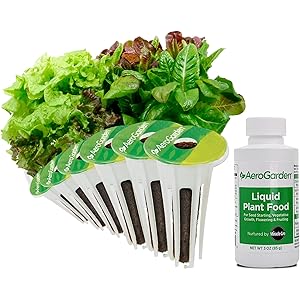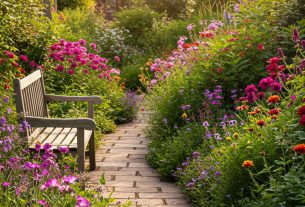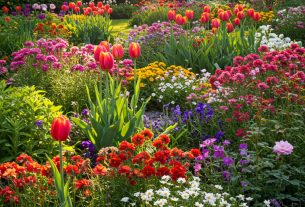Have you ever dreamed of transforming your backyard into a lush, vibrant oasis? A place where you can escape from the hustle and bustle of everyday life and connect with nature? If so, you’re in the right place! Welcome to “Get Gardening with Ruth,” where I invite you to join our green thumb community and embark on a journey to cultivate your dream garden today.
Why Gardening Matters
Gardening is more than just a hobby; it’s a lifestyle that brings numerous benefits to your physical, mental, and emotional well-being. Here are some compelling reasons why you should get started:
- Health Benefits: Engaging in gardening provides a great workout. It helps improve strength, stamina, and flexibility.
- Mental Wellness: Studies show that spending time in green spaces reduces stress and anxiety, promoting a sense of well-being.
- Environmental Impact: Gardening contributes to biodiversity and helps combat climate change through carbon sequestration.
- Food Security: Growing your own fruits and vegetables ensures you have access to fresh, organic produce.
- Creativity and Expression: Your garden is a canvas where you can express your creativity, making it as unique as you are.
Starting Your Gardening Journey
Now that you understand the importance of gardening, let’s dive into how you can start your own gardening journey. Whether you’re a novice or a seasoned gardener, I believe that everyone has the potential to cultivate a beautiful garden.
Step 1: Define Your Goals
Before getting your hands dirty, take a moment to think about what you want to achieve with your garden. Here are some questions to consider:
- What type of garden do you envision? (Vegetable, flower, herb, etc.)
- How much time can you dedicate to gardening each week?
- What is your budget for supplies and plants?
- Are you looking for a space for relaxation, entertaining, or growing food?
Answering these questions will help you create a clear vision for your garden and guide your decisions moving forward.
Step 2: Assess Your Space
Not all gardens are created equal, and the space you have will significantly influence your gardening journey. Consider the following:
- Sunlight: Observe how much sunlight your space receives throughout the day. Most vegetables need at least 6-8 hours of direct sunlight.
- Soil Quality: Test your soil to understand its pH and nutrient levels. This will inform your choice of plants and any amendments needed.
- Space Availability: Determine how much space you have for planting. This will dictate whether you can have a garden bed, container garden, or vertical garden.
Step 3: Choose Your Plants
Choosing the right plants is crucial to your gardening success. Here are some factors to consider:
- Climate: Select plants that thrive in your local climate zone. Research native plants that are well-adapted to your environment.
- Growing Season: Understand the growing season in your area. This will help you decide what to plant and when to plant it.
- Personal Preference: Choose plants that you love and want to see in your garden. This will keep you motivated and engaged.
The Power of Community
One of the most rewarding aspects of gardening is the community that comes with it. At “Get Gardening with Ruth,” we believe that sharing knowledge, experiences, and resources is essential for success. Here’s how you can engage with our community:
Join Our Online Forum
Connect with fellow gardening enthusiasts in our online forum. Share your experiences, ask questions, and learn from others. The collective wisdom of our community is a valuable resource!
Attend Workshops and Events
We regularly host workshops and events where you can learn hands-on skills, meet local gardeners, and exchange plants and seeds. Check our calendar for upcoming events in your area!
Follow Us on Social Media
Stay updated with the latest gardening tips, inspiration, and community highlights by following us on social media. Join the conversation and share your gardening journey with us!
Mastering Gardening Techniques
As you embark on your gardening journey, mastering essential gardening techniques will set you up for success. Here are some fundamental skills to learn:
Soil Preparation
Healthy plants start with healthy soil. Here’s how to prepare your soil:
- Test your soil for pH and nutrient levels.
- Add organic matter such as compost or well-rotted manure to improve soil structure.
- Ensure proper drainage to prevent waterlogging.
Planting Techniques
Proper planting techniques can make a significant difference in your plants’ success. Consider the following:
- Follow the recommended planting depth for each type of plant.
- Space plants appropriately to allow for growth and airflow.
- Water thoroughly after planting to help establish roots.
Watering Practices
Watering is crucial for plant health, but it’s essential to do it correctly:
- Water early in the morning or late in the afternoon to minimize evaporation.
- Use mulch to retain soil moisture and suppress weeds.
- Monitor your plants for signs of underwatering or overwatering.
Pest Management
Pests can be a gardener’s worst nightmare, but there are effective strategies to manage them:
- Encourage beneficial insects like ladybugs and lacewings that prey on harmful pests.
- Use organic pest control methods such as neem oil or insecticidal soap.
- Practice crop rotation to prevent pest buildup.
Success Stories from Our Community
Nothing inspires like real-life success stories. Here are a few examples from our “Get Gardening with Ruth” community:
Jane’s Urban Oasis
Jane, a busy city dweller, transformed her small balcony into a thriving herb garden. By utilizing vertical gardening techniques and choosing compact plants, she now enjoys fresh herbs year-round, enhancing her cooking and bringing joy to her culinary adventures.
Tom’s Vegetable Patch
Tom, a retiree, turned his backyard into a vegetable paradise. With careful planning and seasonal planting, he grows a variety of vegetables that not only feed his family but also allow him to share with neighbors, fostering a sense of community.
Frequently Asked Questions
How much time do I need to dedicate to gardening each week?
The time commitment can vary based on the size of your garden and the types of plants you choose. As a general guideline, starting with a few hours a week is manageable for most beginners.
What are the best vegetables for beginner gardeners?
Some of the easiest vegetables to grow for beginners include radishes, lettuce, zucchini, and tomatoes. These plants are forgiving and thrive in various conditions.
How can I prevent pests in my garden?
Preventing pests starts with healthy plants. Ensure your plants are well-watered and nourished. You can also use companion planting and natural repellents to deter pests.
Do I need special tools to start gardening?
While specialized tools can make gardening easier, you can start with just a few essentials: a trowel, pruning shears, gloves, and a watering can or hose.
Join Us Today!
Are you ready to cultivate your dream garden? Join the “Get Gardening with Ruth” community today! Sign up for our newsletter to receive exclusive tips, resources, and updates on workshops and events. Share this article with your friends and family on social media and invite them to join us in this journey toward greener living.
Conclusion
Gardening is a fulfilling and enriching activity that connects us with nature, promotes health, and fosters community. By joining “Get Gardening with Ruth,” you’ll not only gain access to valuable resources and support but also become part of a vibrant community dedicated to cultivating beautiful gardens and sharing knowledge. So grab your gardening gloves and let’s get started on this exciting journey together!
AeroGarden Heirloom Salad Greens Mix Seed pod Kit with Pre-Seeded Grow pods, Liquid Plant Food, and Growing Guide, 6-Pod
$15.32 (as of 08/12/2025 04:02 GMT -03:00 - More infoProduct prices and availability are accurate as of the date/time indicated and are subject to change. Any price and availability information displayed on [relevant Amazon Site(s), as applicable] at the time of purchase will apply to the purchase of this product.)
Sign up for our newsletter and stay up to date with exclusive news
that can transform your routine!




